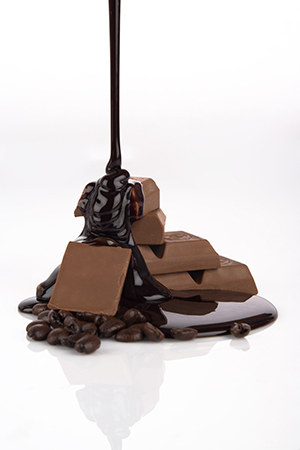 By Benjamin Goodin
By Benjamin Goodin
Exempting a few people who have chocolate allergies, therefore a legitimate explanation, I’ve only met one human being who actively dislikes chocolate. I’ve met a few other sub-humans who don’t really care much for it, but even they can be seduced into eating it in the right forms. It seems an almost species-wide consensus that chocolate is pretty fantastic. Even my dogs demonstrate an unhealthy interest in chocolate (due to a species-wide allergy) that has resulted in the occasional rebirth and inevitable destruction of a chocolate wrapper from our trashcan.
Who could blame us for loving chocolate? I’m sure most of us kickstarted our willingness to consider anything with chocolate as an ingredient at least worth sampling when an adult first offered our chubby childhood hands a chance to wrap around a square of the savory, melty-soft sweet. It probably doesn’t help that the joy of many holidays is reinforced with a chocolaty something — a whipped desert, a pie, gran’s famous cookies, puzzling eggs left by an oversized hare, or maybe a box of candied curiosities from a romantic interest. Most of us know chocolate tastes great, but we also know chocolate feels good too. Modern medicine may even be able to prove that chocolate is good.
Chocolate consumption has been linked, observationally, to a number of health benefits: a reduction in heart disease and dementia, prevention of memory loss, stress reduction, and improvements in insulin resistance. The New England Journal of Medicine has even correlated chocolate consumption to a country’s ability to produce Nobel laureates. The difficulty with most of these promising outcomes, however, is that there is no direct scientific link to chocolate’s ability to reliably produce these results; more study needs to be done in order to find a direct cause-and-effect link to these outcomes. Until science can verify these claims, we can still rely on some proven effects as an excuse to sneak in a few squares of a candy bar here and there.
As far as health benefits are concerned, the most promising research for the glorification of chocolate lies in uncovering the true function of flavonoids: a substance found in cocoa beans that can improve cardiovascular function by relaxing blood vessels. This doesn’t mean that a handful of the beans will prevent a stroke or heart attack, but the flavonoids within could help to manage some of the symptoms.
Researchers have taken note and are currently conducting a study of the effects of a cocoa supplement on general cardiovascular outcomes in older adults. Flavonoid content in any particular brand of chocolate is determined by a few factors: the genetics of the bean it is processed from, the soil that the bean grew in, and the way that the bean was processed into chocolate. Consumers don’t have a lot of control over the first two factors, but their choices in chocolate product can determine how many flavonoids they consume in their confections.
In terms of flavonoid content, not all chocolate is created equal. White chocolate, which is only technically chocolate because it is made with cocoa fats, contains no actual flavonoids. Milk chocolate is a step up because it contains cocoa powder refined from whole beans, but it comes in second because the concentration of cocoa is relatively small compared to the other ingredients, like milk and sugar, that make it palatable. The king of cocoa health benefits is dark chocolate — the darker the better. Dark chocolate not only (generally) contains fewer additives, making it less processed so it contains more of the original nutrition and substances, but it contains higher concentrations of chocolate solids that include, yes, flavonoids. Higher concentration of chocolate solids, the percentage that is prominently displayed on the bar, brings greater health benefits. The one thing to watch out for, which can be difficult since it is not always listed in the nutritional information, is if the chocolate was processed with alkalis in a process called “dutching.” Dutching gives dark chocolate a more pleasing color and less of that pseudo-spicy kick, but neutralizes many of the healthy, active substances in cocoa.
Beyond flavonoid content, dark chocolate also has some other impressive nutritional benefits. About 100 grams of dark chocolate can impart 11 grams, or 44 percent, of your daily fiber intake and 7.9 grams of protein. That same portion contains more free-radical disarming antioxidants than similar portions blueberries and acai berries. You can receive almost your entire daily allotment of manganese and copper from this quantity, in addition to over half of you needs for iron and magnesium. Dark chocolate contains some very mild stimulants and can even help soothe your gut with some moderate probiotic properties — speaking of the gut, it can break down dark chocolate into gentle anti-inflammatories.
The real dilemma of chocolate is this: it may come with some impressive health benefits, but it certainly needs to be taken in moderation. Even dark chocolate is usually sweetened, and sugar consumption can offset some of the net health benefits discussed above. Most importantly, if you know your measurements and conversions, 100 grams of chocolate equals approximately 3.5 ounces, which is about two full bars of chocolate or at least two handfuls of smaller, individually wrapped sweets. Each of the 605 calories in this serving may be completely delicious, but would probably be best divided into a one-third sized portions if you were planning to eat chocolate regularly under the premise that it is technically healthy.
